
The Beardmore Crane was a giant cantilever crane at the William Beardmore and Company yard.

The Beardmore Crane was a giant cantilever crane at the William Beardmore and Company yard.

The Beardmore Crane had two opposite cantilevered jibs, both equipped with moving winches, for a total length of 233 feet (71 m). [1] From the jib to the ground extended a tapering lattice, which was enclosed by a lattice tower. The jib was slewed by a mechanism on the ground, and bearings at the top of the tower and where the extension met the ground allowed it to turn. [1] [2] The winch on each arm was powered by two 52 horsepower (39 kW) electric motors for hoisting and two 14 horsepower (10 kW) motors for slewing, and a 18 horsepower (13 kW) motor for slewing. [1] The tower took eight minutes to make a full revolution. [1]
The height of the rail on which the winches ran was 154 feet (47 m), and communication with the operator was by speaking tube. [1] The total weight of the structure was over 500 tonnes (490 long tons; 550 short tons). [1] Upon completion, the shorter arm was tested to lift 200 tonnes (200 long tons; 220 short tons) at a radius of 72 feet 2 inches (22.00 m) and the longer arm could lift 50 tonnes (49 long tons; 55 short tons) at a radius of 139 feet 5 inches (42.49 m). [1]
Railway tracks running beneath the crane allowed material to be moved from the workshops. [3]
It was used for fitting out ships, installing very heavy items such as boilers, armour and guns. [1] The basin it served was the largest in the world at the time of its completion. [4]
The crane was built by Benrather Maschinenfabrik near Düsseldorf, now Demag, and is similar to a crane built for Vickers in Barrow-in-Furness. [5] The two cranes were the first modern high capacity cranes in Britain. [5] Other shipbuilders installed massive cranes soon after, such as the Titan Clydebank in 1907, although these were typically British-built and of a different design. [6]
The crane was erected in 1903 at a cost of £3,352 by German firm Kohncke. [5] The yard was short-lived, lasting from 1899-1930, but saw significant use during the First World War when it built a number of ships for the Royal Navy. [7]

A crane is a type of machine, generally equipped with a hoist rope, wire ropes or chains, and sheaves, that can be used both to lift and lower materials and to move them horizontally. It is mainly used for lifting heavy objects and transporting them to other places. The device uses one or more simple machines to create mechanical advantage and thus move loads beyond the normal capability of a human. Cranes are commonly employed in transportation for the loading and unloading of freight, in construction for the movement of materials, and in manufacturing for the assembling of heavy equipment.

The Finnieston Crane or Stobcross Crane is a disused giant cantilever crane in the centre of Glasgow, Scotland. It is no longer operational, but is retained as a symbol of the city's engineering heritage. The crane was used for loading cargo, in particular steam locomotives, onto ships to be exported around the world.
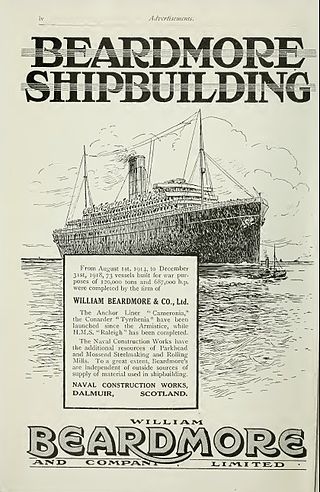
William Beardmore and Company was a British engineering and shipbuilding conglomerate based in Glasgow and the surrounding Clydeside area. It was active from 1886 to the mid-1930s and at its peak employed about 40,000 people. It was founded and owned by William Beardmore, later Lord Invernairn, after whom the Beardmore Glacier was named.

DCV Balder is a deepwater construction vessel (DCV) operated by Heerema Marine Contractors.

HMS E53 was a British E class submarine built by William Beardmore and Company, Dalmuir. She was launched in 1916 and was commissioned in March 1916. E53 was sold for scrap on 6 September 1922.

Stothert & Pitt was a British engineering company founded in 1855 in Bath, England. It was the builder of various engineering products ranging from Dock cranes to construction plant and household cast iron items. It went out of business in 1989. The name and intellectual property became part of Clarke Chapman.

A Fairbairn crane is a type of crane of an 'improved design', patented in 1850 by Sir William Fairbairn. There are numerous hand-powered versions around the world and one surviving steam-powered example in Bristol Docks, England.

Titan was a floating crane that operated in Sydney Harbour from 1919 until 1991. She was fabricated in Carlisle in the United Kingdom, then sent to Cockatoo Island Dockyard in Sydney for assembly, before entering service with the Royal Australian Navy (RAN).

Liebherr is a German-Swiss multinational equipment manufacturer based in Bulle, Switzerland, with its main production facilities and origins in Germany.
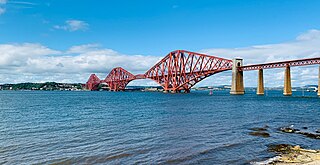
The Forth Bridge is a cantilever railway bridge across the Firth of Forth in the east of Scotland, 9 miles west of central Edinburgh. Completed in 1890, it is considered a symbol of Scotland, and is a UNESCO World Heritage Site. It was designed by English engineers Sir John Fowler and Sir Benjamin Baker. It is sometimes referred to as the Forth Rail Bridge, although this has never been its official name.

The Fairfield Titan was a giant cantilever crane at BAE Systems' Govan shipyard, and the largest such crane on the River Clyde until it was demolished in 2007.
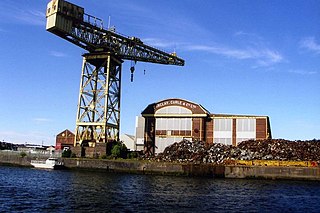
The Barclay Curle Crane is a disused Titan or giant cantilever crane at the Barclay Curle shipyard at Whiteinch, Glasgow, Scotland.

The James Watt Dock Crane is a giant cantilever crane situated at Greenock on the River Clyde.

Langer Heinrich, or in English Long Henry, is a floating crane commissioned in 1915 for the Wilhelmshaven Imperial Shipyard in Wilhelmshaven, Germany and has been located in Genoa, Italy since 1997. At the time of completion she was the largest floating crane in the world, passing up the Ajax crane barge completed in 1914.
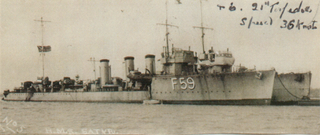
HMS Satyr was an R-class destroyer which served with the Royal Navy during the First World War. Launched on 27 December 1916, Satyr joined the Harwich Force under the command of Commander Hubert de Burgh. In 1917, the destroyer formed part of a force protecting the monitors Erebus and Terror in their bombardment of Ostend. As part of this action, Satyr, along with sister ships Taurus, Sharpshooter and Torrent, sank the German destroyer S20. After the war, the ship served with the Torpedo School at the Devonport. In 1923, the Navy decided to retire many of the older destroyers in preparation for the introduction of newer and larger vessels and Satyr was sold to be broken up on 16 December 1926.

A block-setting crane is a form of crane. They were used for installing the large stone blocks used to build breakwaters, moles and stone piers.
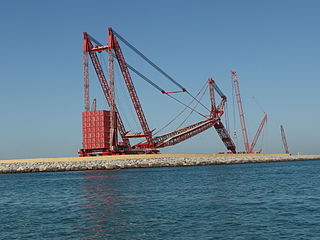
A ring crane is a form of large construction crane with a luffing jib. It is distinguished by its slew pivot being in the form of a ring-shaped track, rather than a narrow central spindle. The broad base this gives to the slewing section above allows it to slew whilst carrying extremely heavy loads.

The Arrol Gantry was a large steel structure built by Sir William Arrol & Co. at the Harland and Wolff shipyard in Belfast, Northern Ireland. It was built to act as overhead cranes for the building of the three Olympic-class liners.

HMS Tancred was an R-class destroyer which served with the Royal Navy during the First World War. The R class were an improvement on the previous M class with geared steam turbines to improve efficiency. Launched by Beardmore of Dalmuir on 30 June 1917, Tancred initially joined the Grand Fleet, serving as part of a flotilla that took part in one of the last naval actions of the war, although in this case the British vessels did not engage with the German High Seas Fleet. After the signing of the Armistice that ended the war and the dissolution of the Grand Fleet, the destroyer was initially transferred to the Home Fleet. However, within a year, Tancred had been allocated to the local defence flotilla at Firth of Forth. Despite being at a reduced complement as an economy measure, further reductions in fleet costs meant that the destroyer was retired. On 17 May 1928, Tancred was sold to be broken up.